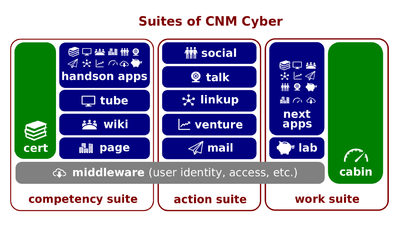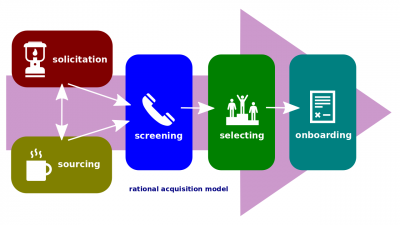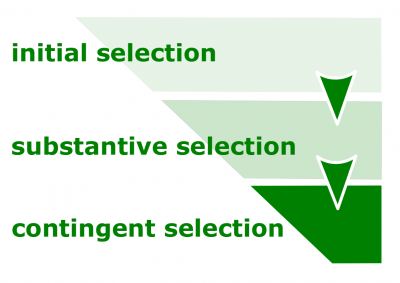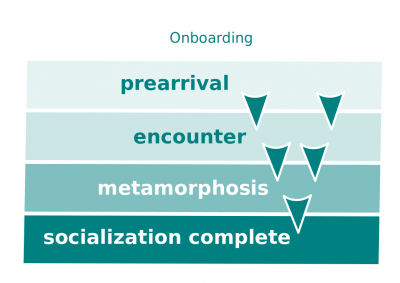Difference between revisions of "Recruitment Essentials"
(→Outline) |
|||
| (14 intermediate revisions by the same user not shown) | |||
| Line 1: | Line 1: | ||
| − | [[File:Cnm-digital.png|400px|thumb|right|[[ | + | [[File:Cnm-digital.png|400px|thumb|right|[[CNMCyber suite]]s]]The [[Recruitment Essentials]] (hereinafter, the ''Lesson'') is the [[lesson]] of [[CNMCyber]] that introduces its participants to [[recruitment]] and related topics. The ''Lesson'' belongs to the '''[[Introduction to Recruitment]]''' session of [[EmployableU Concepts]]. |
| − | The ''Lesson'' is made up of three [[lectio]]s. At [[ | + | The ''Lesson'' is made up of three [[lectio]]s. At [[CNMCyber]], the word, [[lectio]], is used for a lesson part. |
| Line 15: | Line 15: | ||
|- | |- | ||
![[What Recruitment Is]] | ![[What Recruitment Is]] | ||
| − | |1|| | + | |1||[[Recruitment]], [[onboarding]] |
| − | |||
| − | |||
| − | |||
|- | |- | ||
![[What Employer Is]] | ![[What Employer Is]] | ||
| − | | | + | |2||[[Employer]], [[government organization]], [[non-profit corporation]], [[operational business]], [[startup business]] ([[startup business|startup]]) |
|- | |- | ||
| − | ![[ | + | ![[Workforce Dealers]] |
| − | | | + | |3||[[Workforce dealer]], [[staffing firm]], [[temp agency]] |
| − | |||
| − | |||
| − | |||
|} | |} | ||
===Successor=== | ===Successor=== | ||
| − | :The successor lesson is [[ | + | :The successor lesson is [[Sourcing Essentials]]. |
==2019 Recruitment Overview presentation== | ==2019 Recruitment Overview presentation== | ||
| − | The video of the presentation is published | + | The video of the presentation is published on https://youtu.be/u9C98gvUicI (4:44). Here is its full text. |
===Overview=== | ===Overview=== | ||
| Line 40: | Line 34: | ||
===What recruitment is=== | ===What recruitment is=== | ||
| − | :[[File:Acquisition.png|400px|thumb|right|[[Rational | + | :[[File:Acquisition.png|400px|thumb|right|[[Rational Acquisition Model]]]]Recruitment is the process of filling job vacancies with people, to understand the process we will use illustration which represents the [[Rational Acquisition Model]]. The process starts with solicitation and sourcing. So let's say recruiters got order from an employer that for instance we need to fill a vacancy of a book keeper who used to know debit, credit, balance sheet and income statement. |
:And recruiters start to try to understand where these people can be, reach out to the people and to ask or to understand whether these people are looking for a job or are available for a job then the screening process, so recruiters start asking if candidates match the employee requirements. Sometimes hiring managers can be involved in screening but the first preliminary screening is almost always accomplished by recruiters. Then recruiters find several candidates and they give information to hiring managers, then hiring managers make a decision, who from those candidates, who is more qualified and who will be selected. | :And recruiters start to try to understand where these people can be, reach out to the people and to ask or to understand whether these people are looking for a job or are available for a job then the screening process, so recruiters start asking if candidates match the employee requirements. Sometimes hiring managers can be involved in screening but the first preliminary screening is almost always accomplished by recruiters. Then recruiters find several candidates and they give information to hiring managers, then hiring managers make a decision, who from those candidates, who is more qualified and who will be selected. | ||
| Line 53: | Line 47: | ||
===Summary=== | ===Summary=== | ||
| − | :This concludes the ''Recruitment Overview'' presentation. We have defined [[recruitment]] and used the [[ | + | :This concludes the ''Recruitment Overview'' presentation. We have defined [[recruitment]] and used the [[Rational Acquisition Model]] to take a look at the recruitment process. Special considerations were given to [[source selection]] and [[onboarding]]. If you haven't done yet so, you are now welcome to move to ''Recruitment Needs''. |
| − | |||
| − | |||
| − | |||
| − | |||
| − | |||
| − | |||
| − | |||
| − | |||
| − | |||
| − | |||
| − | |||
| − | |||
| − | |||
| − | |||
| − | |||
| − | |||
| − | |||
| − | |||
| − | |||
| − | |||
| − | |||
| − | |||
| − | |||
| − | |||
| − | |||
| − | |||
| − | |||
| − | |||
| − | |||
| − | |||
| − | |||
| − | |||
| − | |||
| − | |||
| − | |||
| − | |||
| − | |||
| − | |||
| − | |||
| − | |||
| − | |||
==See also== | ==See also== | ||
[[Category: Orientation Curriculum]][[Category:Presentations]] | [[Category: Orientation Curriculum]][[Category:Presentations]] | ||
Latest revision as of 19:28, 29 October 2023
The Recruitment Essentials (hereinafter, the Lesson) is the lesson of CNMCyber that introduces its participants to recruitment and related topics. The Lesson belongs to the Introduction to Recruitment session of EmployableU Concepts.
The Lesson is made up of three lectios. At CNMCyber, the word, lectio, is used for a lesson part.
Contents
Summaries
Predecessor
- The predecessor lesson is Labor Regulations.
Outline
Successor
- The successor lesson is Sourcing Essentials.
2019 Recruitment Overview presentation
The video of the presentation is published on https://youtu.be/u9C98gvUicI (4:44). Here is its full text.
Overview
- Welcome to Recruitment Overview. In this brief presentation, we are going to take a look at the general recruitment process, while making special stops by selection and onboarding topics. Let's go into.
What recruitment is
- Recruitment is the process of filling job vacancies with people, to understand the process we will use illustration which represents the Rational Acquisition Model. The process starts with solicitation and sourcing. So let's say recruiters got order from an employer that for instance we need to fill a vacancy of a book keeper who used to know debit, credit, balance sheet and income statement.
- And recruiters start to try to understand where these people can be, reach out to the people and to ask or to understand whether these people are looking for a job or are available for a job then the screening process, so recruiters start asking if candidates match the employee requirements. Sometimes hiring managers can be involved in screening but the first preliminary screening is almost always accomplished by recruiters. Then recruiters find several candidates and they give information to hiring managers, then hiring managers make a decision, who from those candidates, who is more qualified and who will be selected.
- After selection, onboarding process starts. Recruiters may or may not be involved in selecting onboarding, sometimes they are, sometimes they are not.
Source selection
- We take a look at selection better and selection process. The selection goes in three stages; we believe that this candidate can possibly be qualified. Substantive we know this person is qualified but even if we know and if we like the person as an employment candidate and give an offer, usually this offer is contingent selection. So, this offer is contingent on the result of the test or maybe some probaratory period or work or something else.
Onboarding
- Finally, we take a look at onboarding, onboarding is a mechanism of integrating a new employee into the enterprise and it`s culture. Onboarding goes several stages as well, the first stage is pre-arrival, the candidates just heard about for instance Educaship Alliance LLC, and he or she can review materials online, you tube, website then encounter stage comes in, then the employment candidate and employer meet together. If the selection is made that metamorphosis stage comes into the place and here the documents are signed and an employee get costumed into the organization culture, and the organization itself gets a costumed to a new employee.
Summary
- This concludes the Recruitment Overview presentation. We have defined recruitment and used the Rational Acquisition Model to take a look at the recruitment process. Special considerations were given to source selection and onboarding. If you haven't done yet so, you are now welcome to move to Recruitment Needs.



